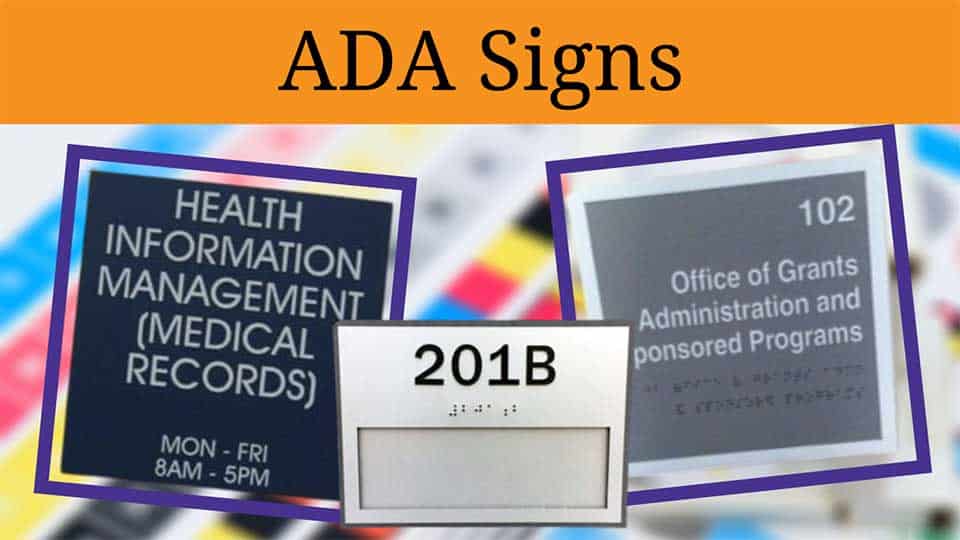In today’s inclusive society, ensuring accessibility is not just a legal requirement but a moral imperative. For businesses and organizations, one crucial aspect of accessibility is ensuring that signage complies with the Americans with Disabilities Act (ADA). In this blog post, we’ll explore the importance of ADA compliance in signage and provide practical tips for navigating regulations effectively.
Understanding ADA Signage Requirements
The ADA sets forth specific guidelines for signage to ensure that individuals with disabilities can navigate public spaces independently. These
guidelines cover various aspects of signage, including font style, size, and color contrast, as well as mounting height and placement requirements. Understanding these requirements is essential for businesses to ensure that their signage is accessible to everyone.
Key elements of ADA signage compliance include:
- Font and Typeface: Signage must use easy-to-read fonts and typefaces without decorative elements that can be difficult for some individuals to decipher.
- Size and Height: Characters on signage must be of a certain size and placed at a specified height above the ground to ensure visibility and readability for individuals of all heights and abilities.
- Color Contrast: Signage must have sufficient color contrast between the text and background to enhance readability for individuals with low vision or color vision deficiencies.
- Braille and Tactile Elements: Signage must include tactile elements such as Braille characters and raised lettering to provide information to individuals who are blind or have low vision.
Implementing ADA-Compliant Signage Solutions
Achieving ADA compliance in signage requires careful planning and execution. Businesses can follow these steps to ensure that their signage meets ADA requirements:
- Conduct an Audit: Start by conducting an audit of existing signage to identify any non-compliant elements. This includes assessing the font, size, color contrast, and placement of signage throughout your facility.
- Invest in Quality Materials: Use high-quality materials for signage to ensure durability and longevity. This includes materials that are suitable for tactile elements such as Braille and raised lettering.
- Work with Professionals: Consider working with signage professionals who have experience in ADA compliance. They can help design and install signage that meets ADA requirements while aligning with your brand identity and aesthetic preferences.
- Educate Staff and Stakeholders: Ensure that staff members and stakeholders are aware of ADA signage requirements and their importance. Provide training on how to recognize and maintain compliant signage throughout your facility.
Embracing Inclusive Signage Design Trends
While ADA compliance is essential for ensuring accessibility, businesses can also go above and beyond to create inclusive spaces through signage design. Here are some inclusive signage design trends to consider:
- Universal Symbols: Use universal symbols and icons to convey information whenever possible. These symbols are easily recognizable across language and cultural barriers.
- Clear Messaging: Keep signage messaging clear, concise, and easy to understand. Avoid jargon or complex language that may be confusing for some individuals.
- Multisensory Elements: Incorporate multisensory elements into signage design, such as tactile materials or audio cues, to provide information in multiple formats for individuals with different sensory abilities.
- Flexible Signage Systems: Implement flexible signage systems that can be easily updated or modified to accommodate changing needs or circumstances. This allows for greater flexibility in providing accessible information to all individuals.
Benefits of ADA Compliance in Signage
Beyond legal compliance, there are numerous benefits to ensuring ADA compliance in signage. These include:
- Enhanced Accessibility: ADA-compliant signage ensures that individuals with disabilities can access and navigate public spaces independently, promoting inclusivity and equality.
- Improved Customer Experience: Accessible signage enhances the overall customer experience by providing clear and easily understandable information to all individuals, regardless of their abilities.
- Positive Brand Image: Demonstrating a commitment to accessibility through ADA-compliant signage can enhance your brand’s reputation and attract customers who value inclusivity and diversity.
- Legal Protection: Compliance with ADA signage requirements helps protect businesses from potential lawsuits and legal liabilities related to accessibility violations.
Navigating ADA compliance is essential for ensuring accessibility in signage and creating inclusive spaces for all individuals. By understanding ADA signage requirements, implementing compliant signage solutions, embracing inclusive design trends, and recognizing the benefits of compliance, businesses can create environments that are welcoming and accessible to everyone. Request a quote for your signs today!




0 Comments